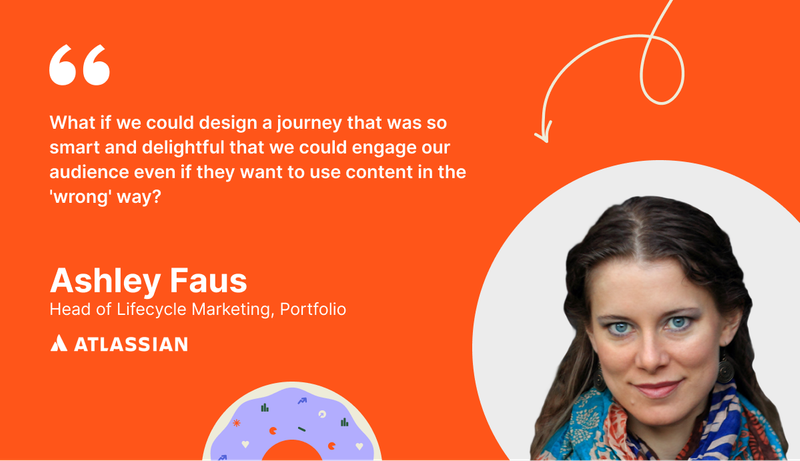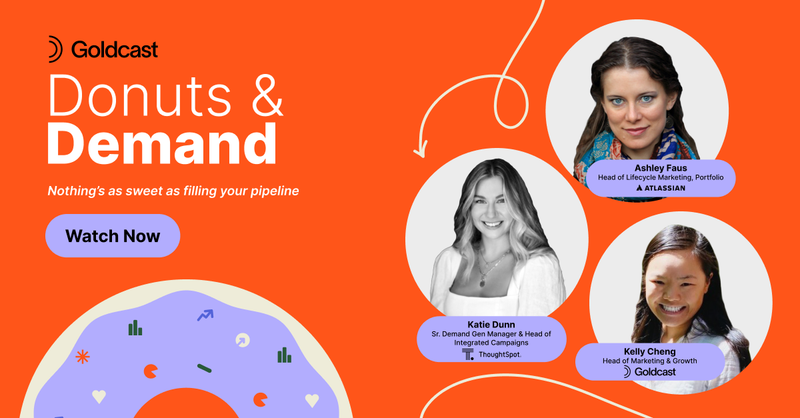What a Children's Playground Can Teach Marketers About Content
Table of Contents
- What marketers can learn from the playground
- How to map content to actual buyer intent
- Your marketing campaigns can only be as successful as your sales team wants them to be
- Enable your sales team via social selling
- Think about longtail distribution from the beginning
- How much content do you plan for each quarter?
- Join us for the next Donuts & Demand!
Maximize Your Marketing ROI
Join 10,000 other marketers already getting the best tips on running engaging events that boost pipeline and create raving fans.
If you've joined us for Donuts & Demand before, you know that some of marketing's coolest demand gen experts drop fresh insights every time—and our conversation with Katie Dunn and Ashley Faus was no exception.
Katie is the Senior Demand Gen Manager and Head of Integrated Campaigns at ThoughtSpot, an AI-powered analytics company. Ashley is the Head of Lifecycle Marketing, Portfolio at tech giant Atlassian, a company that builds tools to help teams enhance collaboration and productivity.
Whether they were sharing sweet story sprinkles to illustrate what marketers can learn from a three-year old on the playground or walking us through how social selling really happens, we loved learning from these two!
Keep reading to find out:
- What marketers can learn from the playground
- How to map content to actual buyer intent
- Your marketing campaigns can only be as successful as your sales team wants them to be
- Enable your sales team via social selling
- Think about longtail distribution from the beginning
- How much content do you plan for each quarter?
- Join us for the next Donuts & Demand!
PS: The full replay of this Donuts & Demand episode is here, and you can sign up for our next session there, too!
What marketers can learn from the playground
Ashley came out swinging with a super hot take:
From her POV, the funnel is dead—use a playground instead. 🎵 What a jingle!
But seriously: As marketers, we get very focused on mapping content in specific ways that show attribution, but that are not always representative of the customer journey.
When you think about a playground, do you think there's a "right" way to play on the playground? Should everyone start on the slide, then move to the swings, then hop on the monkey bars? Is it "wrong" to sit on the park bench and watch others play without joining in? Is it "bad" to go up the slide instead of down it?
Of course, the answer to the above questions is no—there's no "best way" to play on the playground, there's only the way that works for you.
We can apply this same sentiment to marketing, as well as the way we map content to buyer intent.
How to map content to actual buyer intent
You want to design content that meets your audience where they're at, even if they're simply sitting on the park bench taking in the scene right now.

The way to do that is to map your content to audience intent. Many times, marketers confuse learn intent as the only intent out there, so be wary of making this misstep.
If you're teaching someone how to use your product, that's not learn intent; it's use intent content. If you're showing people why they should buy your product, that's buy intent content. If you're teaching folks how to fix a problem in the product, that's help intent content.
Once you're clear on what type of intent you're targeting, you can map the content from there and use clear CTAs that let people know what they should do next and what's going to happen when they take that next step.
Explicit CTAs help everyone because when someone's ready to buy, you're ready to sell to them and you're passing that info off to your sales team, who know they're reaching out to someone who wants to buy. However, if they're just looking for more info, you're not clogging up your pipeline with leads just because they downloaded an ebook.
Your marketing campaigns can only be as successful as your sales team wants them to be
According to Katie, your marketing campaigns are only going to be as successful as your sales team makes them. Because of this, getting that sales-marketing alignment is super critical. You should be partnering with your sales team to be sure you're giving them what they need in terms of pipeline; you should also be doing your part to build pipeline from a marketing POV.
If you look at your pipeline and your various sales stages, where do you see the most significant dropoff? This is an area to really hone in on and identify why this is happening. At ThoughtSpot, when an opportunity is closed at any stage, a reason is provided. That allows the team to look at the reasons and build campaigns accordingly, and Katie's committed to regularly reviewing that info.
One thing she's discovered is that at ThoughtSpot, when the meeting is passed to the seller and the seller takes it, there's a consistent dropoff point. Her team has started building content specifically for the sales team to use at that point in the process, in order to hopefully prevent some of the dropoff.
Enable your sales team via social selling
The Atlassian marketing team does a lot of social selling, which Ashley points out is a misnomer because the way most people use it is to reach out and send a cold message that goes something like this: "Hi (YOUR NAME)! I see that you're a (YOUR TITLE). Do you need to generate more revenue? That's what my company does! Learn more here."
Sound familiar? The major problem being, that's not quite how people socialize!
At the same time, if you look at the low barrier to entry to a tool like LinkedIn, particularly for a B2B SaaS audience, there's no reason not to be using it the right way for social selling. You can find your ICP on the platform and engage with them in comments and by sharing content they'll be interested in. You can tag in other people to continue and grow the conversation. That's social selling, done right.
All the while, you're building trust and positioning yourself as an expert in both the problem and solution spaces.
Check out this clip to learn how Ashley's engaged in social selling herself:
You can see how, just from Ashley weighing in on a poll and providing curated information to people, she raised awareness about Atlassian, was able to pass off a now-hot lead to her sales team, and even secured a speaking engagement for a colleague! That's a super high-value interaction, but it's hard to track via our usual systems because it all happened in comments on social media or in private conversations.
When you're doing the work to socially sell to your network, you're enabling your sales reps with every conversation because by the time you hand off the info, they've got a super qualified lead to speak to—one that you've already primed with information and resources.
Think about longtail distribution from the beginning
Remember that playground analogy? It requires a whole mindset shift, and a part of this is beginning to think about longtail distribution long before you've got your content.
One thing Ashley sees a lot in her presentation is marketers referring to their product or brand by name only once—in the beginning of their talk. From thereon, they call that product/brand "it," which makes it really hard to ever cut the content down and repurpose it because the only place you mentioned what "it" is was in the beginning.
Remember that people don't think in a funnel. They're on that playground roaming around, moving in all different ways, and your content needs to do the same. Make it easy on yourself by producing content that you can reuse as much as possible. When you're presenting, try not to use phrases like, "As I just mentioned," or, "As we were talking about earlier." Instead, simply explain what "it" is that you're talking about so that all the content can be distributed afterward with no issue.
Speaking of content repurposing and distribution—if you're looking for a little help with chopping up your event content into little snippets you can share across platforms, check out Content Lab. It's an AI-powered content wizard that can take any one of your existing recordings and give you key takeaways, social media posts, video clips, and more!
How much content do you plan for each quarter?
We got an audience question this time about how much content Ashley and Katie plan out each quarter. The simplest answer, delivered by Ashley?
It depends.
It's a hard question to answer because, like many teams, the Atlassian group scales up or down depending on what they're seeing in the market.
One thing Atlassian has started doing, like many marketers, is to lean more heavily on content repurposing. They know they have market events every year in Q2 and they have a flagship event in Q4, and they're working to get more runway out of the content for those events.
Meanwhile, for the company's enterprise audience, they invest more in campaigns that result in customer use cases, product stats, and other info. All the while, they're looking for gaps in conversations or in the audience journey where they can invest more in net new content or repurposed content.
At ThoughtSpot, Katie's team meets quarterly to do a content mapping exercise and find out where the pipeline gaps are. From there, they work backwards to see what's possible to pull off with their team size.
Right now, that's led them to focusing their efforts on resources for the BoFu audience, like buyer's guides.

Creating content with this thoughtful approach is a great way to be sure that you're filling any gaps and providing your audience with content that's helpful to them at every stage of the journey.
Join us for the next Donuts & Demand!
Don't forget to catch up on the full episode to learn even more from Ashley and Katie, like what content and syndication vendors they recommend, which demand gen folks they follow for inspiration, their thoughts on AI, and more!

Stay In Touch
Platform
Resources
Company
Community
© 2025 Copyright Goldcast, Inc. All rights reserved.



 Upcoming Events
Upcoming Events Event Series
Event Series On-Demand Events
On-Demand Events

